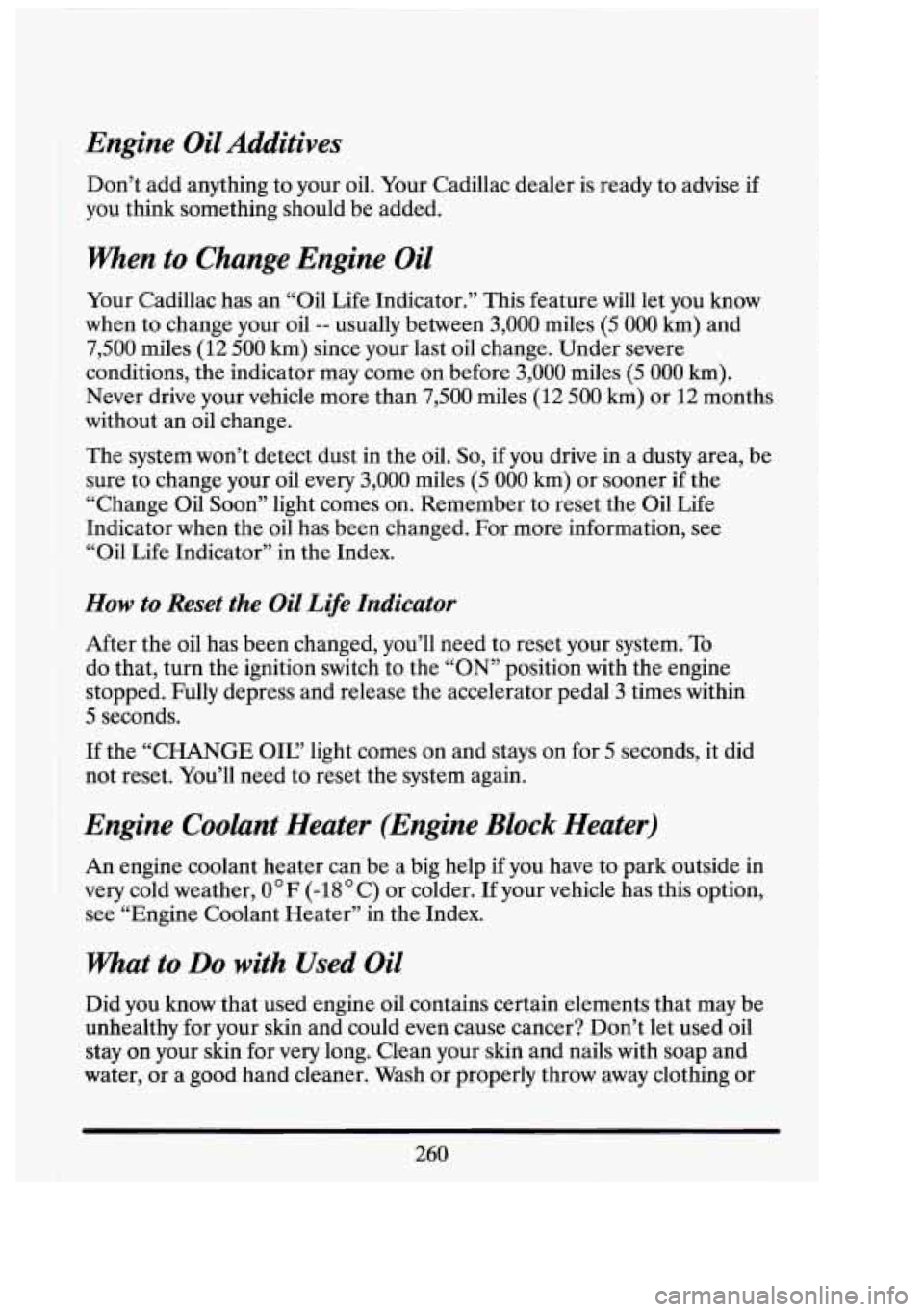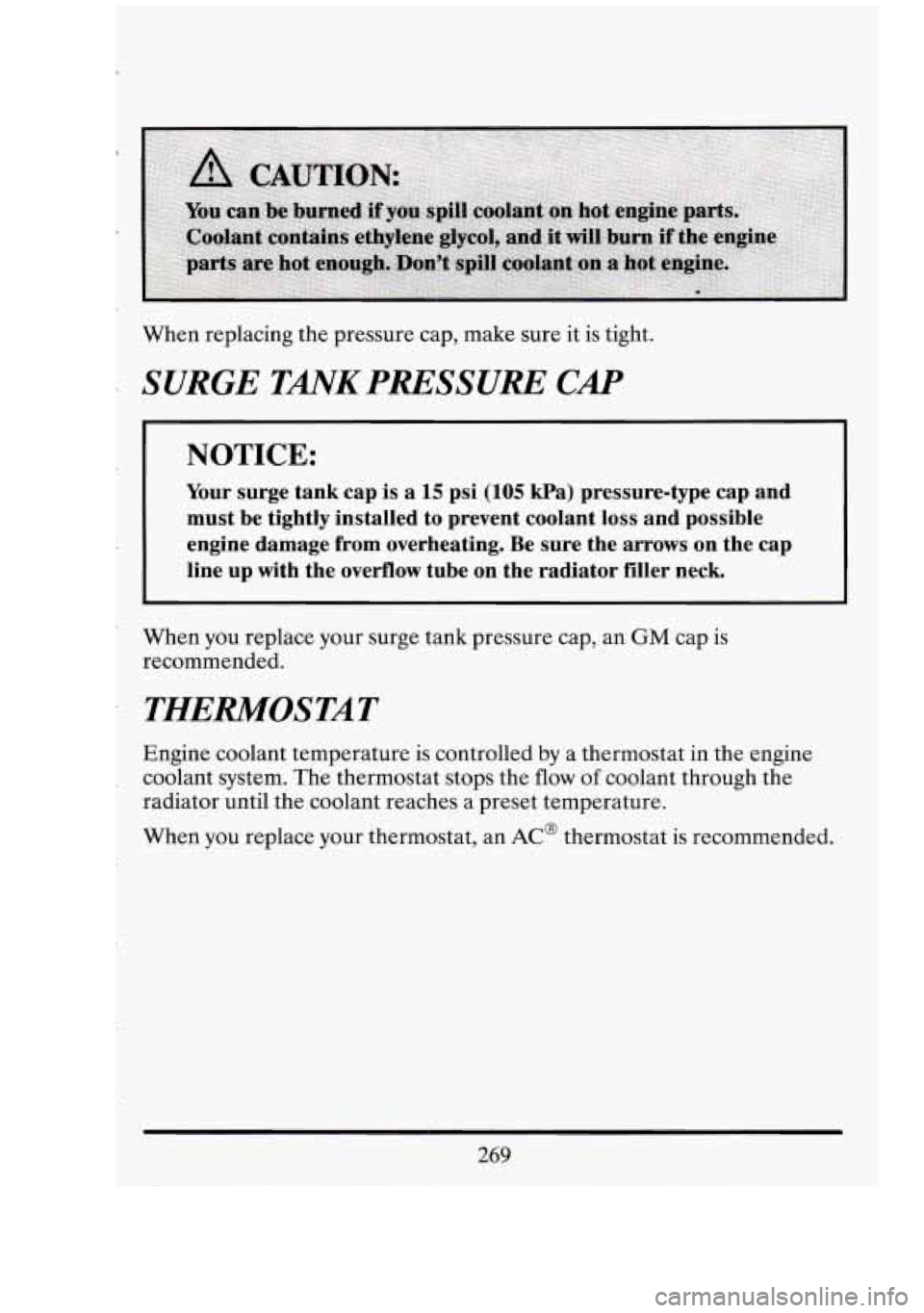1994 CADILLAC FLEETWOOD reset
[x] Cancel search: resetPage 38 of 398

4. Let the belt go back all the way. You should hear a slight clicking
sound.
If you don’t, the adjustment feature won’t set, and you’ll have
to start again.
5. Now you can add a small amount of slack. Lean forward slightly, then
sit back. If you’ve added more than
1 inch (25 mm) of slack, pull the
shoulder belt out as you did before and start again.
If you move around in the vehicle enough, or
if you pull out the shoulder
belt, the belt will become tight again.
If this happens, you can reset it.
25
Page 147 of 398

If the light stays on, turn the ignition off. Or, if the light comes on when
you’re driving, stop as soon as possible and turn the ignition off. Then
start the engine again to reset the system. If the light still stays on, or
comes on again while you’re driving, your Cadillac needs service.
If the
regular brake system warning light isn’t on, you still have brakes, but you
don’t have anti-lock brakes. If the regular brake system warning light is
also on,
you don’t have anti-lock brakes and there’s a problem with your
regular brakes. See “Brake System Warning Light” earlier
in this part.
The anti-lock brake system warning light may also come on when you are
driving with
a compact spare tire. If this happens, the light means you
won’t have anti-lock until you replace the compact spare with a full-size
tire. If the warning light stays
on after you replace the compact spare with
a full-size tire, or if it comes on again when you’re driving, your Cadillac
needs service.
Traction Control System Lights
Traction Engaged
This light will go on as
a bulb check when you
start your engine. It
will also come on when
the traction control
system is active.
Zl
i-‘
I
d
:il
1,
I
134
n t
-
Page 158 of 398

OIL LIFE INDICATOR
Your Cadillac has an Oil Life Indicator feature. This tells you when
you need to change your engine oil. It’s based upon the engine oil
temperatures and your driving patterns.
Your Oil Life Indicator may say to change the oil sooner than your
maintenance schedule. This can happen if driving conditions, such as
short trips in cold weather, cause shorter
oil life. Always keep a written
record of the mileage and date when you last changed your oil. For more
information on when to change your oil, see the Cadillac Maintenance
Schedule Booklet.
The system probably will say to change the oil between
3000 miles
(5000 km) and 7500 miles (12500 km), but it may even say to change it
before
3000 miles under severe conditions. It all depends on your driving
patterns. (If it doesn’t, or if it doesn’t even light up, then something is
wrong. You will need to have it serviced.)
There are
two things the system won’t do: It can’t sense heavy dust in the
places where you drive.
If you drive in a dusty area, you should change
your oil every
3000 miles (5000 km) or 3 months (whichever comes first),
unless the “CHANGE OIC’ light comes on sooner.
It doesn’t check how much oil you have
so you will still have to check for
that.
To check it, see the Index under “Engine Oil.”
When You’ve Changed the Oil
When new oil is put in, you’ll need to reset your system. To do that, turn
the ignition switch to the
“ON” position with the engine stopped. Fully
depress and release the accelerator pedal
3 times within 5 seconds.
If the “CHANGE OIC’ light comes on and stays on for 5 seconds, it did
not reset. You’ll need to reset the system again.
145
Page 169 of 398

I Push the SET button.
Within
.5 seconds, push one of the five push buttons.
Repeat these steps for each of the five push buttons.
PRESET EQUALrZATION
The Preset Equalization buttons let you adjust the tone, to sound just the
way you want it. Each individual auto-equalization button (A through E)
contains a separate equalization adjustment feature.
When your vehicle
is new, the auto-equalization is already preset with
Preset A having more bass and treble tone than mid-range tone. Preset
B
has more bass than treble and mid-range tone. Preset C has an overall flat
response in sound. Preset
D has more treble than bass and mid-range,
and Preset
E has more mid-range sound than bass and treble. These
preset settings can be modified individually for
AM, FM, cassette or
CD play.
Follow these steps to modify each
of the Preset Auto-equalization
buttons.
. ,\%:. .. . . ,! - ;, .: ,,; !:;;? ;.y=K&> .I.‘!.;,*’ .:. ~ -4 6°K; -..L,.l __ .. , s+.qb+‘’ ,:Li;%j :&;% ,:
First, seTect’one oft e Preset Equ
, . .. 9- : , -;.;I< f?,;., ;,x 7 ..f& * -q$; ;’{ :!&i”Y,.
2. Equalization Band
3. Equalization Gain (1 thru 15) I
- i’ &:i ,; -4% @ -. 1.. - --.. ,tu:. J
0 Press the SET button’, and then press and hold the Preset Equalization I
I
button you have selected, until either an “F” or “U” is displayed
(about
10 seconds).
Page 170 of 398

The display will show either 3 or 4 digits and the preset button “LED”
will flash. In the farthest right position of the display will be an “F”
(for factory setting), or if the equalization has been modified, a “U”
(for user setting).
Press the SCAN switch up or down to select the band you prefer.
The middle digit indicates the equalization band. There are five bands
60Hz, 250Hz, lkHz, 3.5Hz and lOkHz, numbered
1 through 5
respectively. The band will display band 1 when the mode is first entered.
Press the SEEK switch up or down to select the gain setting you want.
The left digit, or
two digits are the equalization gain settings (0-15) for
each band. The display
will indicate the active setting (F or U) when
the mode is first entered.
A typical setting for a flat response is 7.
0 Press the upper radio knob to compare the factory setting to your
setting. Once you are satisfied with your selection, press and hold the
preset equalization button for about
4 seconds, the“ Pr” (program)
will display indicating that your selection is programmed.
If you have programmed the preset equalization buttons and set the push
buttons to the stations you’ve selected, you can preset the five Preset
Equalization buttons to a particular station. Just:
Tune in a station using one of the preset push buttons.
157
Page 171 of 398

0 Push one of the Preset Equalization buttons (A thru E) until you like
0 Push the SET button.
4 Push the same Preset Equalization button you've selected.
the sound.
0 Push
the preset push button again to set the Preset Equalization tone.
Now each time you push that push button, the Preset Equalization is set
in memory for that station.
For Example:
Suppose you like classical music with a flat sounding tone. The station has
already been preset to push button
3. Since the flat response is on button
C, you would just:
Push the preset push button 3.
Push the tone control button C.
Now, push the SET button.
Push the tone control button C again.
~ Push the Preset push button 3 again and your Preset Equalization is
set in memory.
Now every time you push the preset push button
3, the Preset
Equalization tone is programmed to that preset push button. Tuning to
the station already preset to
3 using the knob, or Seek or Scan, the tone
control will automatically change to
C. The Preset Equalization button
will light when it is programmed to a particular push button or when
manually
pushed in.
Your Cassette Tape Player
Your cassette tape player works best with tapes that are 30 to 45 minutes
long on each side. Tapes longer than that are
so thin that they may not
work well in this player.
158
o/
Page 273 of 398

Engine Oil Additives
Don’t add anything to your oil. Your Cadillac dealer is ready to advise if
you think something should be added.
When to Change Engine Oil
Your Cadillac has an “Oil Life Indicator.” This feature will let you know
when to change your oil
-- usually between 3,000 miles (5 000 km) and
7,500 miles (12 500 km) since your last oil change. Under severe
conditions, the indicator may come on before
3,000 miles (5 000 km).
Never drive your vehicle more than 7,500 miles (12 500 km) or 12 months
without an oil change.
The system won’t detect dust
in the oil. So, if you drive in a dusty area, be
sure to change your oil every 3,000 miles
(5 000 km) or sooner if the
“Change Oil Soon” light comes on. Remember to reset the Oil Life
Indicator when the oil has been changed. For more information, see
“Oil Life Indicator” in the Index.
How to Reset the Oil Life Indicator
After the oil has been changed, you’ll need to reset your system. To
do that, turn the ignition switch to the “ON” position with the engine
stopped. Fully depress and release the accelerator pedal
3 times within
5 seconds.
If the “CHANGE OIC’ light comes on and stays on for 5 seconds, it did
not reset. You’ll need to reset the system again.
Engine Coolant Heater (Engine Block Heater)
An engine coolant heater can’be a big help if you have to park outside in
very cold weather,
0 F (-18 C) or colder. If your vehicle has this option,
see “Engine Coolant Heater” in the Index.
What to Do with Used Oil
Did you know that used engine oil contains certain elements that may be
unhealthy for your skin and could even cause cancer? Don’t let used oil
stay
on your skin for very long. Clean your skin and nails with soap and
water, or a good hand cleaner. Wash or properly throw away clothing or
-1
c:
I 3‘
260
Page 282 of 398

When replacing the pressure cap, make sure it is tight.
SURGE TANK PRESSURE CAP
NOTICE:
Your surge tank cap is a 15 psi (105 kPa) pressure-type cap and
must be tightly installed to prevent coolant loss and possible
engine damage from overheating. Be sure the arrows on the cap \
line up with the
overflow tube on the radiator filler neck.
When you replace your surge tank pressure cap, an GM cap is
recommended.
THERMOSTAT
Engine coolant temperature is controlled by a thermostat in the engine
coolant system. The thermostat stops the
flow of coolant through the
radiator until the coolant reaches a preset temperature.
When you replace your thermostat, an
AC@ thermostat is recommended.
269